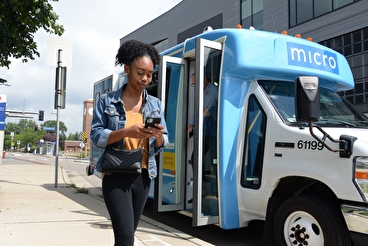
Mobility-on-Demand, Battery-Electric Buses May Relieve Transit Woes

Alireza Khani, Associate Professor, Civil, Environmental, and Geo- Engineering
Area of Expertise: Traffic Engineering & Management
The COVID-19 pandemic exacerbated two major challenges to American public transit systems and provider agencies—declining ridership and bus driver shortages.
One significant corollary of declining transit ridership is the attendant rise in automobile use, a pattern that leads to higher levels of congestion and carbon emissions. Since 2012, ridership declines across major agencies have hit bus routes and nighttime periods hard. With the onset of the pandemic, however, ridership declines impacted peak commute periods heavily as many workers shifted to work-from-home status.
Beyond the disruption of the pandemic, transit agencies have been dealing with more durable reasons for decreasing ridership:
- Perceived lower cost of driving
- Convenience of driving (especially in auto-oriented regions)
- Insufficient transit services
- Fare costs
Agencies can also consider systems such as mobility-on-demand (MOD) to innovatively connect riders to transit in new ways...MOD offers the chance to embrace the wider use of electric vehicles (EVs)...Expanding the use of MOD and EVs will also ensure that a wider range of users can access and benefit from these systems.
There are a variety of ways for agencies to attract riders. Some interventions rely simply on building out more frequent, reliable service. This is especially productive in denser urban areas. At Metro Transit in the Twin Cities, for example, new bus rapid transit lines with more frequent and reliable service have seen faster ridership growth than local service lines. Technology improvements such as more coordinated fare systems across both transit and shared mobility services are other potential interventions. Agencies can also consider systems such as mobility-on-demand (MOD) to innovatively connect riders to transit in new ways. Many agencies have begun to explore how to connect riders over the “first or last mile,” using systems like Uber/Lyft or other shared modes such as scooters. These pilot projects have yielded mixed results, particularly where they rely on the continued support of private companies. In lieu of that reliance, some agencies such as Metro Transit have instituted their own MOD pilots using smaller, non-fixed-route buses.

MOD also offers the chance to embrace the wider use of electric vehicles (EVs). Complementing fixed-route transit with e-modes—whether carshare, ride-hailing, or bikesharing—offers an effective strategy to serve car-oriented areas and still promote a “car-light” lifestyle. Embracing MOD could also help expand the growing use of mobility hubs, where multiple modes connect near higher density homes and commercial areas, providing people with more mobility options. Expanding the use of MOD and EVs will also ensure that a wider range of users can access and benefit from these systems. Finally, more flexible, interconnected systems can reduce the operating cost for transit providers and, therefore, transportation costs for riders.
Another opportunity to increase transit service quality and reduce operating costs is to employ battery-electric buses (BEB) in transit fleets. BEBs are clean, quiet, and agile, providing a more comfortable ride to users. Coupling investment in BEBs with improvements in frequency are the sort of actions that could help attract riders back to or onto transit. But two major obstacles with adopting BEBs are their high cost and the upfront infrastructure needed for charging.
Recent federal investments, however, make a significant amount of funding available for both vehicles and charging infrastructure improvements. The increased use of BEBs will require more careful scheduling to ensure vehicles can provide uninterrupted service despite more limited range and charging needs—and charging may need to occur off-peak to reduce cost and grid impacts. Advanced data science methods could help agencies craft BEB plans and provide real-time improvements once they are in use.
Technology and new investments won’t solve the issue of driver shortages, however. Studies show that 71 percent of agencies have had to cut service because of a driver shortage and 9 out of 10 struggle with hiring new drivers. Among the contributing factors to the shortage are low wages, driver safety and security concerns, and the inconvenience of split shifts. Multiple agencies have begun to address these issues, such as by implementing pay increases and new approaches to scheduling. Changes brought by MOD or BEBs could also impact the driver's experience, with BEBs offering quieter, more comfortable driving and e-MOD creating more flexibility and different interactions with riders. Adopting new electric vehicles will also require agencies to staff and train for a range of new roles, including technicians for both vehicles and charging infrastructure.
Investing in MOD and BEB will require that transit providers explore a range of challenges, including:
- Implementing new system planning practices to ensure e-mobility hubs and charging networks are most effectively placed.
- Monitoring how charging and usage patterns of BEBs affect operations.
- Employing data science knowledge to explore post-pandemic human mobility patterns and needs in the presence of shared mode options.
- Soliciting customer perceptions of the new systems and approaches and working with a range of populations to ensure they are comfortable and informed about the transition.
- Studying how the shift to BEBs and MOD services could impact both their overall finances and workforce.
However, faced with a range of challenges after the pandemic, transit agencies should be looking for solutions in new practices and new technologies.